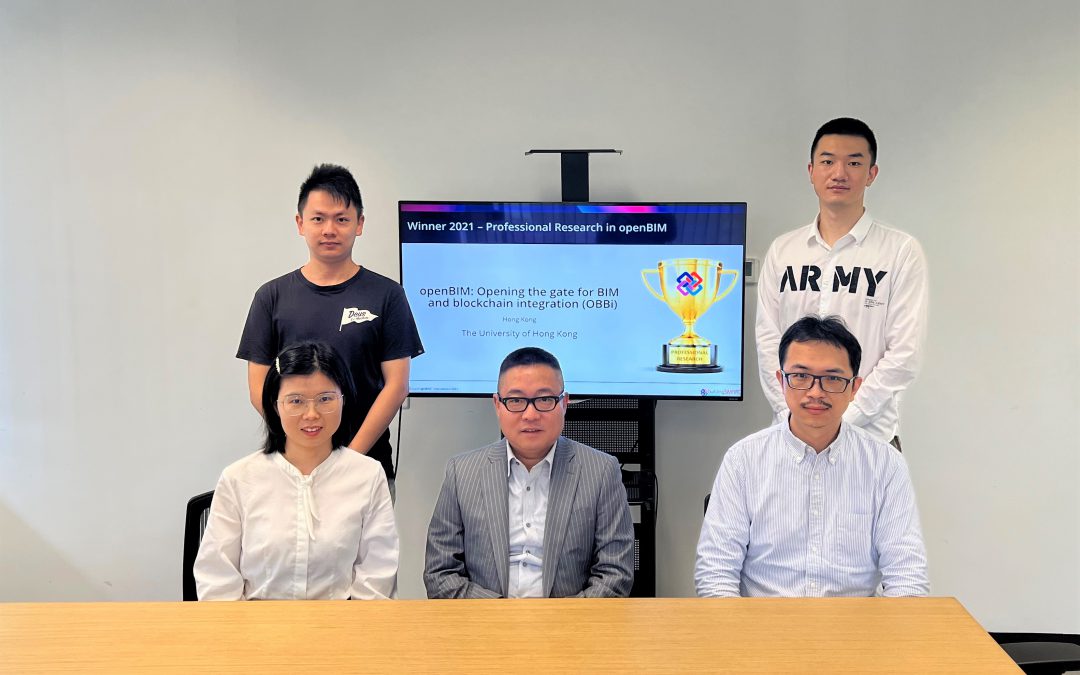A team led by Professor Wilson Lu, Dr Frank Xue (Assistant Professor) and Dr Jinying Xu (Post-Doctoral Fellow) at iLab, Faculty of Architecture, The University of Hong Kong (HKU) won the buildingSMART International (bSI) Awards 2021 in the “Professional Research” category. Their project is called “OpenBIM: Opening the gate for BIM and blockchain integration (OBBi)”.
The bSI Award is a prestigious international award programme initiated since 2018 with an aim to promote OpenBIM for project design, construction, operation, research, and technology. In this year, there were 133 submissions entering the eight categories of the Award. The submissions were predominantly from developed, BIM-advanced countries/regions. A highly selective jury was formed to shortlist 3 finalists in each category, deliberating their presentations, and finally selecting a single winner from each category. The OBBi submitted by iLab is the sole winner in the Professional Research category. It is also the sole winner from Hong Kong across all the 24 finalists.
HKU Press Release https://www.hku.hk/press/press-releases/detail/23422.html
Appearing in local newspapers 頭條日報 stheadline http://shorturl.at/kEGJN
星島日報 Singtao Diary http://shorturl.at/dqK06
巴士的報 Bastillepost http://shorturl.at/gtTW3
bSI website report: https://www.buildingsmart.org/awards/bsi-awards-2021/winners-2021/
About the winning project – OBBi
The global architecture, engineering, and construction (AEC) community is exploring the benefits that can be instigated by Building Information Modelling (BIM) and blockchain integration. BIM is considered both a technology and process innovation to develop a digital representation of physical and functional characteristics of a facility (e.g., a building, a bridge, and so on) so it can serve as a reliable information basis for stakeholders to make decisions through the facility’s lifecycle. BIM is widely deemed the most disruptive development across the global AEC industry over the past two decades or so. Blockchain is known by many through Bitcoin. It is widely promoted for other uses due to its power of enhanced security, augmented traceability, increased efficiency, improved transparency, and reduced costs. According to the UK Institute of Civil Engineers (2018), BIM can take information from blockchain, e.g., material provenance, supply chain status, installation instructions, and contracts; and building information can be assigned to blockchain to be used later, e.g., for smart payment, procurement, traceability, or forensic investigation. However, there are three key obstacles:
- lack of interoperability between the existing commercial BIM software and blockchain;
- information redundancy if directly storing BIM in blockchain; and
- resemblance and swiftness of retrieving the information from blockchain and restore to BIM.
The iLab team developed an innovative idea to overcome the above obstacles. In a nutshell, the idea is to convert commercial BIM into OpenBIM in IFC (Industry Foundation Classes) format, calculate their changes (i.e., Semantic Differential Transaction, SDT), and put the small SDT file in blockchain; one can reserve the process to retrieve the information from blockchain and restore onto BIM. Four vital layers, including (1) Commercial BIM, (2) Web OpenBIM interface, (3) OpenBIM semantics-based server backend, and (4) Blockchain-based BIM data storage are designed for visualization, SDT records minimization and changes authenticity (See Figure 3). Particularly, the SDT model developed by the iLab team (Xue and Lu 2020) is able to differentiate the chronological changes and eliminates the information redundancy between IFC models using Python script compiled with the library of IFCOpenShell and IFCJson. With the OpenBIM blockchain and two Revit add-ons, the OBBi system can resolve the information authenticity and redundancy at the same time.

